What Are The Signs of Balding at 20? Complete Guide in 2025
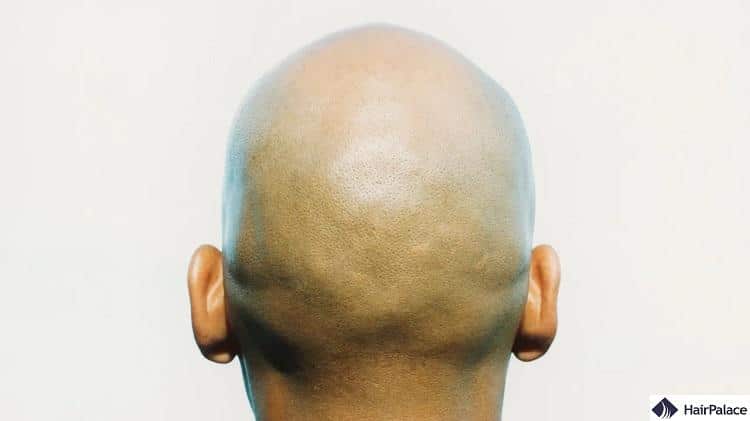
Hair loss can be devastating to experience at any age, especially if you notice the signs of balding at 20.
Signs of balding at 20 include a receding hairline, particularly at the temples, forming an M-shaped pattern, and noticeable thinning of hair on the crown or top of the scalp.
These symptoms can indicate the onset of androgenetic alopecia, influenced by genetic and hormonal factors.
But rather than panic, we’re here to tell you that there are plenty of things you can do it treat, limit, and even prevent further hair loss from developing.
This article will explain the most common reasons for losing hair in your 20s, and share expert tips on improving your hair and treating your condition.

Is it normal to lose hair in your 20s?
Hair loss is one of the most common conditions worldwide.
Although we often assume it affects us as we age, a growing number of people are reporting noticeable hair loss earlier and earlier than before.
There can be many causes of hair loss in your 20s, some avoidable, others sadly unavoidable.
For example, poor genetics can result in hereditary conditions that make hair loss almost inevitable.
This is the most common reason for hair loss in teenage male patients.
But that’s not to say you’re completely helpless either, as starting treatment in your early 20s can stop, limit and prevent future hair loss in young men.
Simple lifestyle changes like de-stressing, improving your diet, or avoiding certain products and styling techniques can help reduce symptoms and improve hair appearance.
Treatments and procedures like laser therapy, medication, to surgeries like hair transplantation can also be hugely beneficial.
That said, the best way to find out how to stop hair loss in teenage guys is to find the root cause of the problem.
To ensure the most effective approach, it’s advisable to consult a doctor who can accurately diagnose the underlying cause and provide tailored guidance regarding your hair fall at 20.
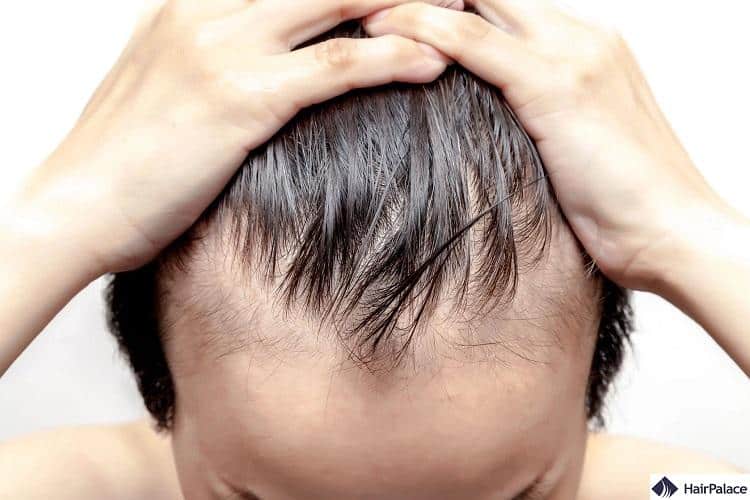
How many men go bald in their 20s?
Although hair loss is often associated with getting older, research suggests that teenage hair loss in male patients is on the rise.
In research studies, up to 20% of men aged between 20 and 30 reported suffering some or significant hair loss.
This number steadily increases as men get older, with 50%- 66% of men reporting noticeable hair loss in their 50s and 60s.
| Age | Percentage of men with noticeable hair loss |
|---|---|
| 20 | 20% |
| 30 | 25% |
| 50 | 50% |
| 60 | 66% |
What are the signs of balding at 20?
Treating hair loss in teenage males as soon as possible is essential to stopping progression and hopefully recovering and stimulating new regrowth.
While there are many potential causes of baldness, below are four of the most common signs of balding at 20 you should be aware of:
1. Receding hairline
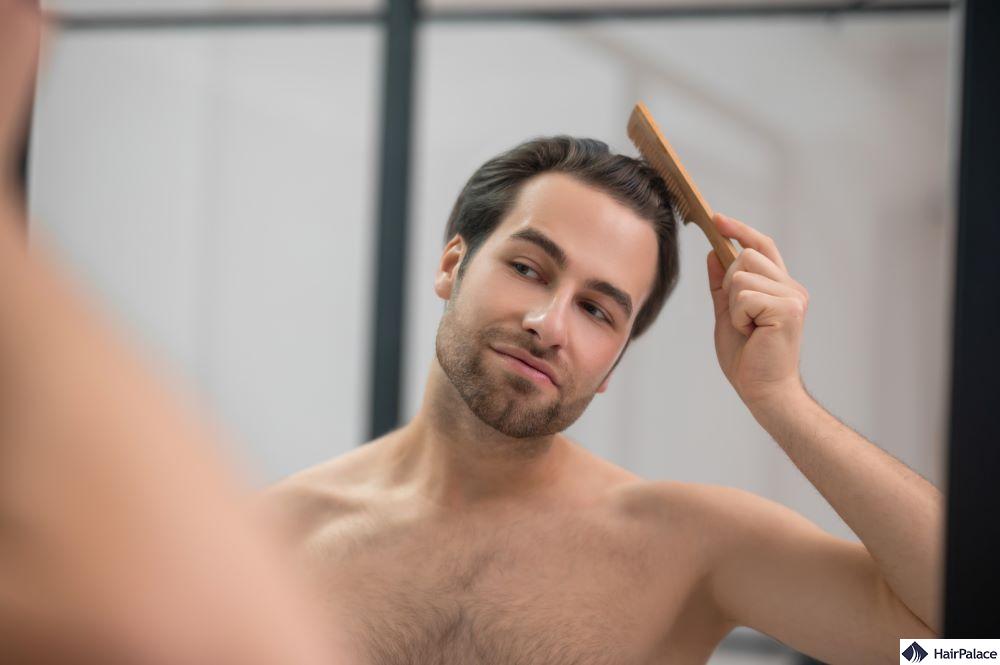
One of the most common signs of developing baldness is a receding hairline.
This can happen at the front and top of your scalp, where hair retreats backwards.
2. Developing patchy bald spots
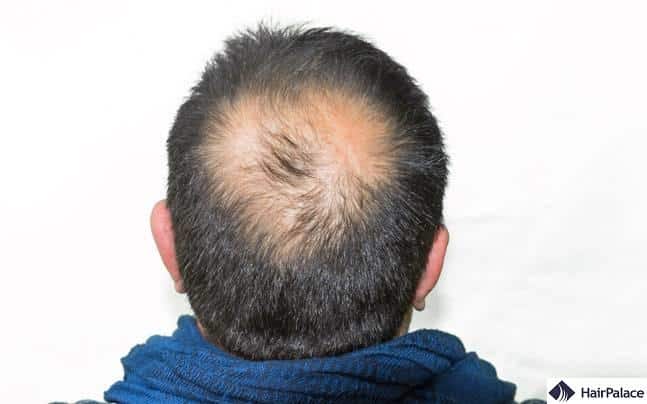
Another key sign of developing baldness in your 20s is seeing your scalp easily through your hair.
This can take the form of gradual hair thinning across your scalp or the appearance of a bald spot on the crown.
Early crown hair loss can be particularly distressing for young adults.
3. Slower hair growth
Slow hair growth can be another one of the warning signs of balding at 20.
This is because something disrupts your hair’s natural growth cycle, leading to thinning hair in your 20s.
Concentrate on improving your intake of B Vitamins, protein, iron, and zinc; you should see noticeable improvements.
4. Excessive hair loss in the shower
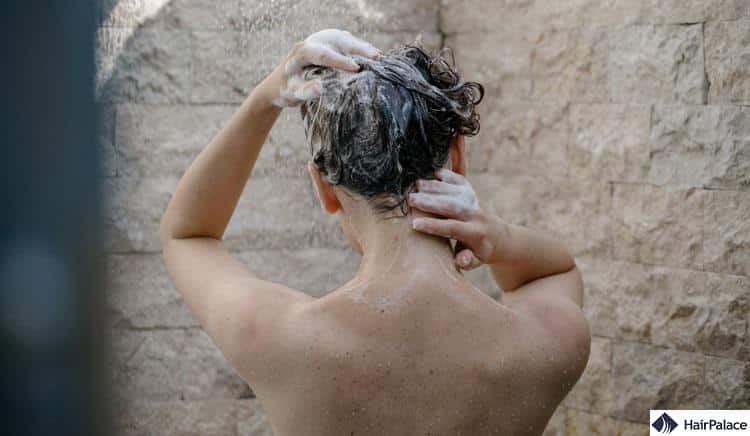
One of the easiest ways of identifying the condition and resilience of hair is when showering.
Pull a small patch with your hand, and examine how many strands fell out.
It is usual for two or three hairs to be pulled out, but if more hair comes out, this indicates you’re developing a hair loss condition.
What can cause balding in your 20s?
Unfortunately, there can be many different reasons why you might lose hair at a young age.
Genetics is perhaps the most common culprit for a receding hairline in your 20s.
Hereditary conditions like male pattern baldness, for example, affect millions worldwide and start to manifest by producing signs of balding at 20.
But other factors can be the root cause of your baldness, some of which you can avoid or correct with simple treatments or lifestyle changes.
Below are 6 of the most common contributing factors for baldness:
1. Androgenic alopecia (male pattern baldness)
One of the most common conditions is androgenetic alopecia, otherwise known as male pattern baldness.
If your parents or people in your family experienced hair thinning and eventual hair loss, there might be a high chance you will also develop a similar condition.
People of African and Asian descent are more likely to develop a hereditary hair loss condition and, thus, permanent hair loss.
2. Hormonal imbalance
Although many people assume hormone changes happen later in life, they can still begin to affect your hair in your early 20s.
Stress, a poor diet, medication, significant life events like pregnancy, surgery, or developing an underlying condition can all have a massive impact on your hormone levels.
This, in turn, can disrupt your hair’s natural growth cycle, resulting in thinning hair and severe hair loss.
3. Excessive stress
When stressed, our body releases a powerful hormone called cortisol which can limit or shut down certain body functions.
High cortisol levels can disrupt the natural growth cycle of a hair follicle, leading to increased hair shedding and bald spots.
4. Poor nutrition
Eating lots of processed fats and fast foods can deprive your body of the fuel to sustain healthy growth across your entire body.
You can often prevent the gradual thinning of hair by eating a healthy diet rich in proteins, minerals, and nutrients.
5. Medications
Some medications may cause you to experience hair loss in your 20s.
These range from antidepressants, mood stabilizers, and blood thinners to blood pressure medication, chemotherapy, and radiation treatments.
6. Alopecia areata
As an autoimmune condition, alopecia areata causes your immune system to mistakenly attack healthy parts of your body, including hair follicles.
You may experience slight patchy hair loss, complete baldness, itchiness and flaking, and tenderness across your scalp.
Hair loss at 20 male solution

Various treatments are available for both men and women to treat, manage or otherwise hide the signs of baldness. But which one is right for you?
There are a number of factors to consider, including the root cause of your hair loss, the severity, if it has stagnated yet, and whether you want an invasive or non-invasive solution.
Ultimately, visiting your doctor or haircare specialist for a formal diagnosis would be best.
Share your concerns and any signs of balding you might be experiencing with them.
They can recommend an appropriate treatment for hair loss in teenagers, from non-invasive options like medication to surgeries like a hair transplant.
How to stop balding at 20?
Some of the most popular remedies for going bald in your early 20s include:
- Minoxidil is a topical treatment that increases blood flow to follicles and stimulates new hair growth.
- Finasteride is a DHT blocker that is often able to prevent hair loss from progressing.
- Hair transplant is suitable for minor or extensive baldness, but generally ill-advised for younger patients.
It isn’t a preventative treatment, so there is no guarantee that you won’t experience additional hair loss around the transplanted area. - Scalp reduction removes bald areas of your scalp, leaving room for hair growth.
- Hair accessories are non-invasive solutions to hide bald spots and mask hair loss.

Conclusion
Balding can be a pretty unfortunate thing to experience at any age, but especially in your 20s.
The most important thing to remember is not to panic. In many cases, hair thinning is treatable, preventable, and in some instances, reversible.
The first step is identifying the signs of balding at 20 and then addressing their root cause.
Visit your doctor or dermatologist to address your concerns and receive a formal diagnosis.
They will be able to examine your scalp, run some tests, and recommend the most appropriate treatments for you to try.
Only then can you properly treat the condition, correct unhealthy habits, slow or stop its progression, and ultimately promote hair growth again.
FAQ
Balding at 20 can be due to a variety of reasons including genetics (hereditary pattern baldness), hormonal changes, medical conditions, or stress. It’s important to consult with a healthcare professional to determine the specific cause and explore possible treatments.
Last medically reviewed on June 23rd, 2025
- Piraccini BM, Alessandrini A. Androgenetic alopecia. G Ital Dermatol Venereol. 2014 Feb;149(1):15-24. PMID: 24566563.https://pubmed.ncbi.nlm.nih.gov/24566563/
- York K, Meah N, Bhoyrul B, Sinclair R. A review of the treatment of male pattern hair loss. Expert Opin Pharmacother. 2020 Apr;21(5):603-612. doi: 10.1080/14656566.2020.1721463. Epub 2020 Feb 17. PMID: 32066284.https://pubmed.ncbi.nlm.nih.gov/32066284/
- Manabe M, Tsuboi R, Itami S, Osada SI, Amoh Y, Ito T, Inui S, Ueki R, Ohyama M, Kurata S, Kono T, Saito N, Sato A, Shimomura Y, Nakamura M, Narusawa H, Yamazaki M; Drafting Committee for the Guidelines for the Diagnosis and Treatment of Male- and Female-Pattern Hair Loss. Guidelines for the diagnosis and treatment of male-pattern and female-pattern hair loss, 2017 version. J Dermatol. 2018 Sep;45(9):1031-1043. doi: 10.1111/1346-8138.14470. Epub 2018 Jun 4. PMID: 29863806.https://pubmed.ncbi.nlm.nih.gov/29863806/
- Mounsey AL, Reed SW. Diagnosing and treating hair loss. Am Fam Physician. 2009 Aug 15;80(4):356-62. PMID: 19678603.https://pubmed.ncbi.nlm.nih.gov/19678603/
- Imhof RL, Davis DMR, Tollefson MM. Hair Loss. Pediatr Rev. 2020 Nov;41(11):570-584. doi: 10.1542/pir.2019-0009. PMID: 33139410.https://pubmed.ncbi.nlm.nih.gov/33139410/
- Happle R. Genetic hair loss. Clin Dermatol. 2001 Mar-Apr;19(2):121-8. doi: 10.1016/s0738-081x(00)00122-x. PMID: 11397589.https://pubmed.ncbi.nlm.nih.gov/11397589/
- Sinclair R. Diffuse hair loss. Int J Dermatol. 1999 May;38 Suppl 1:8-18. doi: 10.1046/j.1365-4362.1999.00003.x. PMID: 10369535.https://pubmed.ncbi.nlm.nih.gov/10369535/


